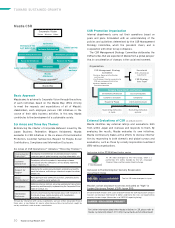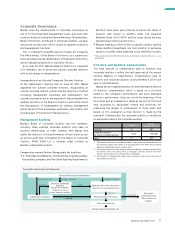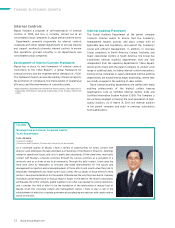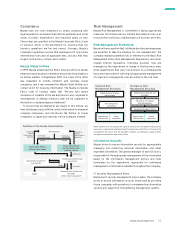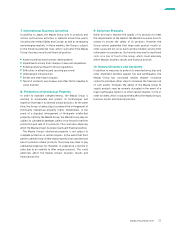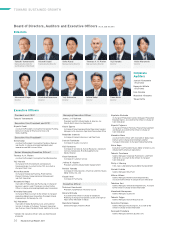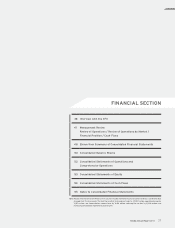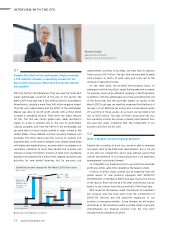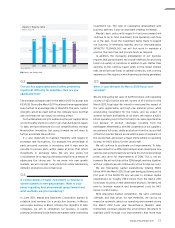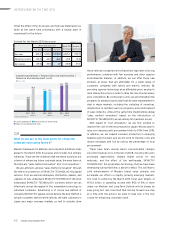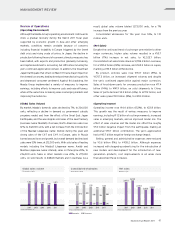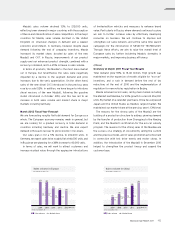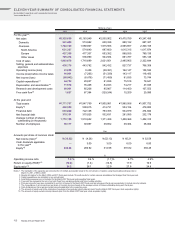Mazda 2011 Annual Report Download - page 41
Download and view the complete annual report
Please find page 41 of the 2011 Mazda annual report below. You can navigate through the pages in the report by either clicking on the pages listed below, or by using the keyword search tool below to find specific information within the annual report.
Q3
The yen has appreciated even further, presenting
significant difficulty for exporters. How are you
addressing this?
The average exchange rate for the March 2010 fiscal year was
¥93/US$. During the March 201 1 fiscal year, the yen appreciated
even further, to an average rate of ¥86/US$. The yen’s current
strength cannot be dealt with at the company level, but that
does not mean we can simply do nothing, either.
Our fundamental policy for addressing the yen’s appreciation
is to thoroughly improve costs for cars manufactured in Japan.
To date, we have enhanced our cost competitiveness through
Monotsukuri Innovation, but going forward we will need to
further accelerate these efforts.
It is also important to maintain flexibility with regard to
exchange rate fluctuations. For example, the percentage of
parts procured overseas is increasing, and it may even be
possible to procure parts within Japan at prices that reflect
movements in exchange rates. We are also giving full
consideration to increasing overseas production as a means of
addressing the strong yen. As we move into new growth
markets, we will consider local production while maintaining
domestic production at a certain level.
Q4
A certain degree of major investment is required to
achieve growth in emerging markets. What is your
policy regarding fund procurement going forward and
what methods are you considering?
In June 201 1, Mazda and Sumitomo Corporation agreed to
establish joint ventures for a production business in Mexico
and a sales business in Brazil. Utilizing the strengths of both
companies, we aim to strengthen our business in rapidly
growing Central and South American markets while controlling
2007 2008 2009 2010 2011
479.9
554.2
414.7
509.8
430.5
24.8
27.8
22.9
26.1
24.2
Equity / Equity ratio
Billions of yen / %
(As of March 31)
investment risk. This type of cooperative development with
business partners is also an important strategy for Mazda.
Mazda’s basic policy with regard to fund procurement will
continue to be to fund investment from operating cash flow,
as in the past. Given the investment being made to expand
our business in emerging markets and for new-generation
SKYACTIV TECHNOLOGY, we will first work to maintain a
positive free cash flow, and procure funds as required.
In addition, the increasing globalization of our business
requires that going forward, we consider methods for procuring
funds in a variety of currencies in addition to yen. Rather than
deciding on the currency based solely on the lowest interest
rate, we will procure funds in optimal currencies, with a strong
awareness of the regions in which earnings are being generated.
Q5
What is your forecast for March 2012 fiscal year
earnings?
We are forecasting net sales of ¥2,190.0 billion, with operating
income of ¥20.0 billion and net income of ¥1.0 billion for the
March 2012 fiscal year. We intend to overcome the impact of
the yen’s appreciation and high raw material prices, while
accelerating investment for the future, and we expect to
achieve full-year profitability at all levels. We expect a ¥20.0
billion operating loss for the first half, from sales opportunities
lost because of product shortages resulting from the
earthquake. Nevertheless, with the cooperation of our suppliers,
we achieved full-scale, stable production from the second half
of the first quarter. We will accelerate the pace of shipments in
the second half, and expect a major improvement in operating
income, to ¥40.0 billion, for the second half.
We will continue to accelerate cost improvements. To date,
we have aimed for a 20% improvement when developing new
vehicles, but going forward we will raise this by five percentage
points and strive for improvements of 25%. This is not all,
however. We will not stop at the 25% target; working together
with our suppliers we will continuously strive to improve costs.
We are forecasting capital expenditures totaling ¥80.0
billion. With the March 2012 fiscal year being positioned as the
first year of the SKYACTIV era, we plan to increase capital
expenditures by roughly ¥35.0 billion from the March 201 1
fiscal year, focusing on new-generation products. Similarly, we
plan to increase research and development costs by ¥4.0
billion, to ¥95.0 billion.
With intensified market competition, the yen’s continued
strength, and high prices for raw materials, we can by no
means be optimistic about our operating environment during
the March 2012 fiscal year. Nevertheless, Mazda’s sales
momentum continues despite this environment. We intend to
maintain profit through cost improvements that more than
Equity Equity ratio
Mazda Annual Report 201 1 39



